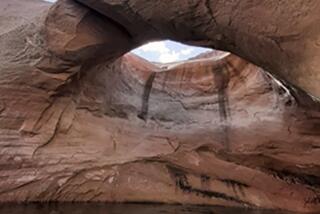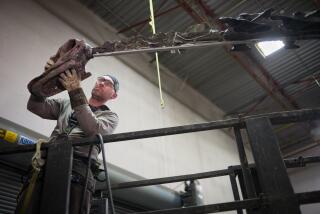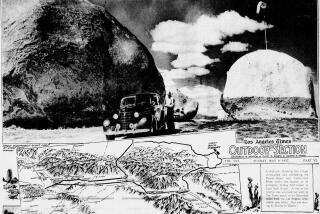Dinosaurs Roamed Utah National Monument
SALT LAKE CITY — Unique dinosaur discoveries are turning up in southern Utah, particularly in the Grand Staircase-Escalante National Monument.
Among the region’s finds are dinosaurs previously unknown to science, a trail where a dinosaur plodded along dragging its tail, a sea creature with 4-foot jaws and ancient Indian rock art that seems to suggest that North America’s earliest human inhabitants were curious about the extinct beasts.
“This state has the most continuous record of Cretaceous dinosaurs anywhere in the world, and, basically, the heart of the record is the Grand Staircase,” James I. Kirkland, Utah state paleontologist, said, referring to the national monument north of Lake Powell.
“We’re never going to know all the sites down there. It’s obviously an incredibly fossiliferous place.”
The exploration was spurred in part by the presidential proclamation that set up Grand Staircase-Escalante National Monument in 1996. The proclamation says the area contains the most continuous records of Late Cretaceous terrestrial life in the world.
The Late Cretaceous period ended about 66.4 million years ago.
Getting the fossils out of the 1.7-million-acre monument can be a challenge. In August, the Utah Geological Survey worked to extract the skull of a horned dinosaur called a ceratopsid.
The scientists had to use sheer brawn to drag it out because the region is off-limits to vehicles.
Kirkland described the effort in the recent edition of “Survey Notes,” published by the state’s geological survey. The skull was about a third of a mile from the nearest road, and the excavation permit specified that no wheeled vehicle could be used to extract the massive sandstone blocks that contained the skull fragments, he wrote.
To drag the stone blocks to the road, the scientists jacketed the rock in protective plaster. They then used the roof of an old car as a sled, dragging it with a long rope.
Getting the skull out took five days. “Oh boy, that was hard,” Kirkland said.
Kirkland said cleaning the sandstone from the skull and stabilizing the fossil will take another year.
During an initial survey of the monument, a University of Utah student discovered the trail of a sauropod, a big, long-necked, small-headed dinosaur. The tracks showed up clearly in the sandstone surface. The sauropod dates to the middle of the Jurassic, the era that preceded the Cretaceous period, Kirkland said.
In a different find, an Indian pictograph panel replicates a three-toed dinosaur footprint.
More to Read
Sign up for Essential California
The most important California stories and recommendations in your inbox every morning.
You may occasionally receive promotional content from the Los Angeles Times.










